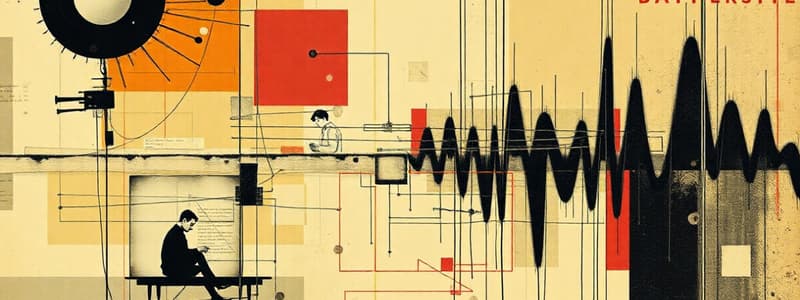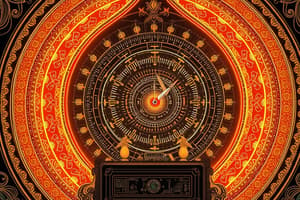Podcast
Questions and Answers
What defines a digital signal?
What defines a digital signal?
- A signal that can vary its amplitude without boundaries.
- A signal with discrete time and discrete values. (correct)
- A signal that reflects natural phenomena continuously.
- A signal with continuous time and continuous values.
Which of the following is an example of a continuous-time signal?
Which of the following is an example of a continuous-time signal?
- Digital audio recordings.
- Digital photographs.
- Electrocardiograms. (correct)
- Digital video.
Which of the following statements is true about discrete-time signals?
Which of the following statements is true about discrete-time signals?
- They may correspond to a sampled version of continuous-time signals. (correct)
- They are always analog in nature.
- They have an infinite range of possible values.
- They can only represent time-based data.
What best describes the signal shown in a digital image?
What best describes the signal shown in a digital image?
The position, velocity, and acceleration of a moving body are examples of which type of signals?
The position, velocity, and acceleration of a moving body are examples of which type of signals?
Which characteristic distinguishes continuous-time signals from discrete-time signals?
Which characteristic distinguishes continuous-time signals from discrete-time signals?
What type of signals are processed by digital computers?
What type of signals are processed by digital computers?
Which of the following is NOT a characteristic of a digital signal?
Which of the following is NOT a characteristic of a digital signal?
What is a system with only one input and one output classified as?
What is a system with only one input and one output classified as?
Which of the following describes a system that handles both continuous-time and discrete-time signals?
Which of the following describes a system that handles both continuous-time and discrete-time signals?
In the simple RC network described, what is the output of the system?
In the simple RC network described, what is the output of the system?
Which classification applies to a system that processes only digital signals?
Which classification applies to a system that processes only digital signals?
What type of system is characterized by processing signals in a discrete manner?
What type of system is characterized by processing signals in a discrete manner?
What functionality might a signal processing system provide for electrocardiogram signals?
What functionality might a signal processing system provide for electrocardiogram signals?
What characteristic defines a multi-dimensional system?
What characteristic defines a multi-dimensional system?
If a system has multiple inputs but only one output, it is referred to as which type of system?
If a system has multiple inputs but only one output, it is referred to as which type of system?
What defines a discrete-time signal?
What defines a discrete-time signal?
Which notation correctly represents the nth element of a sequence x?
Which notation correctly represents the nth element of a sequence x?
Which of the following is an example of a continuous-time signal?
Which of the following is an example of a continuous-time signal?
What is the primary function of a system in signal processing?
What is the primary function of a system in signal processing?
Which of the following accurately describes output signals in a communications system?
Which of the following accurately describes output signals in a communications system?
In the context of systems, what does the input represent in a robotics system?
In the context of systems, what does the input represent in a robotics system?
What graphical representation is depicted by Figure 1.3?
What graphical representation is depicted by Figure 1.3?
How are continuous-time and discrete-time signals typically represented?
How are continuous-time and discrete-time signals typically represented?
What mathematical framework is necessary for designing systems to ensure they meet specifications?
What mathematical framework is necessary for designing systems to ensure they meet specifications?
Which term describes systems that have only one input and one output?
Which term describes systems that have only one input and one output?
Which chapter is focused on continuous-time linear time-invariant (LTI) systems?
Which chapter is focused on continuous-time linear time-invariant (LTI) systems?
Which transform is introduced as a mathematical tool for studying continuous-time signals?
Which transform is introduced as a mathematical tool for studying continuous-time signals?
What is the primary focus of Chapters 8 through 12 in the book?
What is the primary focus of Chapters 8 through 12 in the book?
Which mathematical aspect does Chapter 4 specifically study?
Which mathematical aspect does Chapter 4 specifically study?
Why is the multi-dimensional case described as beyond the scope of this book?
Why is the multi-dimensional case described as beyond the scope of this book?
What does the book primarily present regarding signals and systems?
What does the book primarily present regarding signals and systems?
What is the primary function of a Continuous-to-Discrete (C/D) converter?
What is the primary function of a Continuous-to-Discrete (C/D) converter?
In a system processing a discrete-time signal with a continuous-time system, which type of converter is used at the output stage?
In a system processing a discrete-time signal with a continuous-time system, which type of converter is used at the output stage?
What does a discrete-time signal represent in the context of signal processing?
What does a discrete-time signal represent in the context of signal processing?
In a communication system, what is the role of the receiver?
In a communication system, what is the role of the receiver?
What is likely the effect of using a Continuous-Time (C/T) system to process a Discrete-Time (D/T) signal?
What is likely the effect of using a Continuous-Time (C/T) system to process a Discrete-Time (D/T) signal?
Which type of signal does a Discrete-to-Continuous (D/C) converter produce?
Which type of signal does a Discrete-to-Continuous (D/C) converter produce?
Why is it essential to perform signal conversion between continuous and discrete formats?
Why is it essential to perform signal conversion between continuous and discrete formats?
What do the terms 'before processing' and 'after processing' in signal diagrams indicate?
What do the terms 'before processing' and 'after processing' in signal diagrams indicate?
Flashcards are hidden until you start studying
Study Notes
Signals
-
-
Signals can be continuous-time or discrete-time.
-
Continuous-time signals are defined for all time values.
-
Discrete-time signals are defined only at specific time points.
-
Digital signals have discrete values; analog signals have continuous values.
-
A digital image represents a discrete-time signal.
can be continuous-time or discrete-time
-
-
Continuous-time signals are defined for all values of time
-
Discrete-time signals are defined only at discrete points in time
-
Digital signals have discrete values
-
Analog signals have continuous values
-
A digital image is a discrete-time signal, even if the independent variables are not time
-
Examples of continuous-time signals include: voltage, current, electrocardiograms, speech, music, position, velocity, acceleration, forces, torques, and flow rates
-
Examples of discrete-time signals include: digital video, digital photographs, and digital audio data
-
Discrete-time signals can correspond to a sampled version of a continuous-time signal
-
The Dow Jones Industrial Average stock market index is an example of a discrete-time signal because it is only defined on daily intervals
-
The nth element of a sequence x is denoted as either x(n) or xn
Systems
- A system processes one or more input signals in order to produce one or more output signals
- A system can be classified based on the number of inputs and outputs
- A system can be classified based on the types of signals it interacts with
- A system that deals with continuous-time signals is called a continuous-time system
- A system that deals with discrete-time signals is called a discrete-time system
- A system that handles both continuous- and discrete-time signals is called a hybrid system
- A system that deals with digital signals is referred to as digital, while systems that handle analog signals are referred to as analog
- A one-dimensional system interacts with one-dimensional signals
- A multi-dimensional system handles multi-dimensional signals
- Systems can manipulate signals in many different ways and serve many useful purposes
- Systems can extract information from their input signals, such as speaker identification or voice recognition
- Systems can analyze electrocardiogram signals to detect heart abnormalities
- Systems can amplify signals and reduce noise
Basic Systems
- An RC network has a source voltage vs as input and a capacitor voltage vc as output
- Signal-processing systems can use a discrete-time system (like a digital computer) to process a continuous-time signal
Communications Systems
- Elements of a communication system include: message signal, transmitted signal, received signal, transmitter, channel, receiver
- The system can process the received signal to extract the message signal
Feedback Systems
- A feedback control system uses a sensor to measure an output signal
- The feedback system uses a controller to compare the measured output to a desired input signal
- The controller generates an error signal
- The controller uses the error signal to adjust the plant (the system being controlled), to reduce the error
Studying That Suits You
Use AI to generate personalized quizzes and flashcards to suit your learning preferences.




